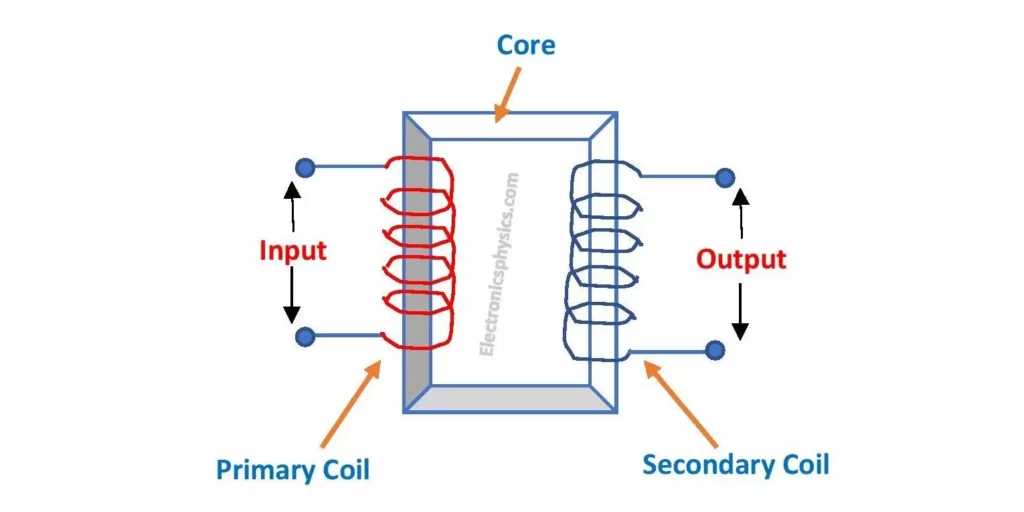Electricity Transformer is an electrical component that transforms the alternating electric power from one circuit to another circuit with the same frequency of the signal. It can change the amplitude of alternating voltage to a desired value at the output. But the power remains the same both at the primary and secondary coil. In this article, we’re going to discuss the working principle, formula and use of a Transformer. The working principle of step-up and step-down transformers are also discussed here.
Contents in this article:
- Construction of a Transformer
- Working principle of a Transformer
- Formula of Transformer
- Step Down Transformer
- Step Up transformer
- Use of a Transformer
What is an Electricity Transformer?
Electricity Transformer is an electrical component that transfers input alternating power at the output with the same frequency. This Power transfer occurs by changing alternating current and voltage. An ideal transformer transforms the entire input power at the output, but a practical transformer losses a part of the input power.
Construction of a Transformer

A transformer consists of two coils – one is a primary coil and the other is a secondary coil. Both coils may have an equal or different number of turns. These two coils are wound on a rectangular core made of soft iron or steel. The Input signal is used to connect to the primary coil and the load is connected to the secondary coil.
Working Principle of a Transformer
Transformers work on the principle of electromagnetic induction. When an alternating current flows through the primary coil it produces a varying magnetic field around it including the position of the secondary coil. This produces a varying magnetic flux linked with the secondary coil which induces a voltage in the secondary coil.
Here coils are wound in a soft iron core so that the maximum magnetic flux can pass through the secondary coil and maximum EMF induces. Again, some eddy current also induces in the cross-section of the core which causes the loss of energy. To reduce the effect of eddy current, the core of the Transformer is laminated into several parts.
The induced EMF in the secondary coil is the output voltage corresponding to the applied input voltage at the primary coil. The voltage of each coil is different and depends on the number of turns. But the output voltage in each coil remains the same. Thus, it transfers the same electric power from input to output.
Working Formula of a Transformer
A Transformer has only two basic working formulae. If Np and Ns be the number of turns and Vp and Vs be the voltages in primary and secondary coil respectively, then
i) The ratio of the voltage at primary to the secondary is equal to the ratio of Number of turns in those coils.
Hence, \small {\color{Blue} \frac{V_{p}}{V_{s}} = \frac{N_{p}}{N_{s}}} ………………(1)
ii) Again, total power at primary coil is equal to the total power of the secondary coil.
so, IPVP = IsVs ……………… (2)
Equation-1 and equation-2 are the basic formula of a Transformer.
Types of Transformers
On the basis of working, there are two types of Transformers,
- Step Up Transformer
- Step Down Transformer
Step-up Transformer – working principle and equation
Step Up transformer helps to increase the magnitude of alternating voltage at the output. But the power and frequency remain same as that of the input. Working principle and equations of a Step Up transformer are similar to that of a general transformer. But the turn ratio of the coils are different. For a Step-up Transformer, the secondary coil has greater number of turns than the primary one (Ns>Np) which helps to induce greater voltage at the secondary coil.

In the above diagram we can see that the magnitude or the amplitude of alternating voltage increases ( from 5 volts to 10 volts) after passing through the transformer. Clearly, it is a Voltage step-up transformer. Since power remains same, the current at output will decrease due to increase in voltage. So, at the same time this transformer is stepping down the current at the output. Thus, the Step up Voltage transformer is also a Step down current transformer.
Step-down Transformer – working principle and equation
The working principle of a step down transformer is similar to that of a step up transformer. But a step down transformer decreases the magnitude of voltage at output keeping the power and frequency same. To construct a step down transformer we need to make the number of turns in secondary coil smaller than that of the primary coil (Np>Ns). The number of turns in the coils decide whether it will be a step up or a step down transformer.

In the diagram of a step down transformer, one can see that the voltage is decreasing or stepping down (from 10 volts to 6 volts) at the output. But to keep the same power, the output current increases. Thus, if a transformer is step down for voltage and it is the step up for the current.
Use of a Transformer
The main purpose of a Transformer is to transfer the electric power from input to output keeping the frequency the same. Step Up Transformer gives greater output voltage and lower output current. On the other hand, a step down transformer gives lower output voltage and higher output current. One can use step up or step down transformer in electrical circuits to get alternating voltage of a desired amplitude.
This is all from this article on the construction, working principle and formula of a Transformer. If you have any doubts on this topic you can ask me in the comment section.
Thank you!
Related Posts:
Comments are closed.